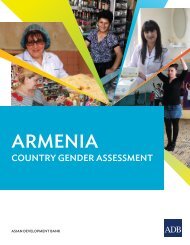Civic Activism as a Novel Component of Armenian Civil Society
English-3
English-3
You also want an ePaper? Increase the reach of your titles
YUMPU automatically turns print PDFs into web optimized ePapers that Google loves.
eport higher levels <strong>of</strong> trust in online media 17 and social networks 18 and are more frequent users<br />
<strong>of</strong> social networking cites <strong>as</strong> a source <strong>of</strong> information about current events and news. 19<br />
Settlement type: The majority <strong>of</strong> people in Yerevan (58%) report having used the<br />
Internet in the p<strong>as</strong>t 12 months, while this is not the c<strong>as</strong>e in other urban settlements and rural<br />
are<strong>as</strong>, where 45% and 36% <strong>of</strong> respondents reported doing so, respectively. The difference is<br />
statistically significant. 20 People in Yerevan are less trustful <strong>of</strong> online media and social networks,<br />
compared to residents <strong>of</strong> rural are<strong>as</strong>, 21 although they use social networking cites more frequently<br />
to obtain information about current events and news. 22<br />
4.2.2. Actual and Potential Activists<br />
<strong>Civic</strong> initiatives need popular support. If activists want to attract more people to their cause, it is<br />
logical to target people that are more inclined towards taking political action. We use WVS data<br />
on four types <strong>of</strong> non-conventional political participation, discussed above (petitions, boycotts,<br />
demonstrations and strikes), <strong>as</strong> me<strong>as</strong>urements <strong>of</strong> political activism. To simplify the analysis, we<br />
recalculated the original variables into new dummy variables, combining the “have done” and<br />
“might do” response categories, thus creating a simple dichotomy between people who said they<br />
would never engage in the type <strong>of</strong> political activity mentioned and those who are willing to or<br />
have already done so.<br />
We examine each <strong>of</strong> the four types <strong>of</strong> political actions, <strong>as</strong>sessing whether age, gender,<br />
education and income influence the likelihood <strong>of</strong> participation. We also note whether the picture<br />
in 2011 is different from that in 1997. Table 2 below summarises the results <strong>of</strong> t-test and chisquare<br />
analysis. Only statistically significant results are reported.<br />
16 T-test: t(1373) = 14.289, p < 0.001 for year 2013.<br />
17 Pearson’s r = 0.212, N = 661, p < 0.001 for year 2013.<br />
18 Pearson’s r = 0.163, N = 629, p < 0.001 for year 2013.<br />
19 Pearson’s correlation: r = -0.364, N = 1359, p < 0.001 for year 2013.<br />
20 Chi-Square: X 2 = 46.946, df = 2, p < 0.001 for year 2013.<br />
21 ANOVA: F(2, 675) =3.684, p < 0.05 for online media variable and F(2, 645) =3.906, p < 0.05 for the social<br />
network variable for the year 2013.<br />
22 ANOVA: F(2, 1381) =19.400, p < 0.001 for year 2013.<br />
30



